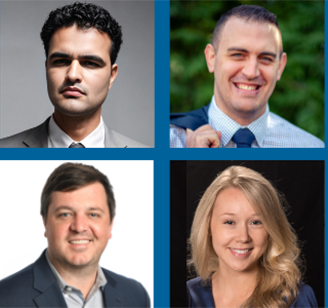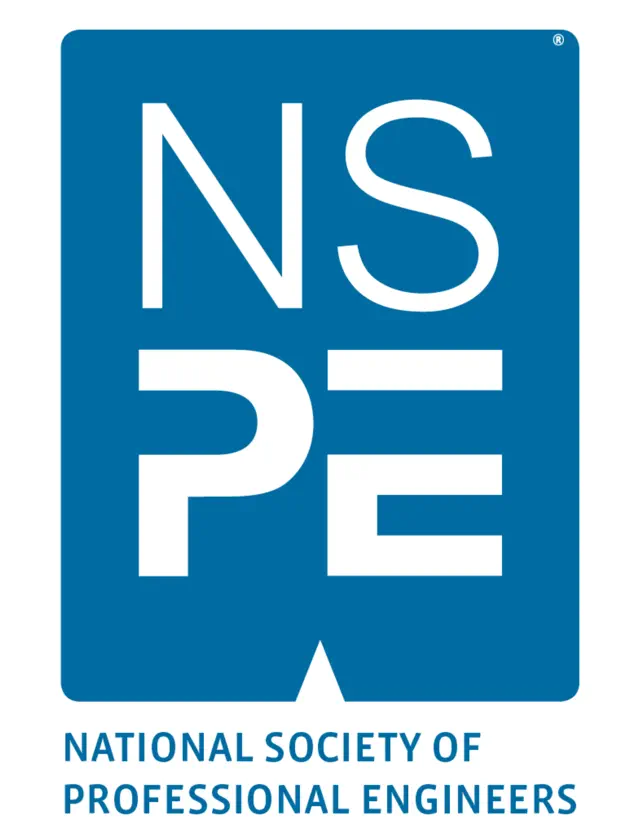September/October 2019
In Focus: Ethics
Back to School
BY PATRICK INGRAHAM
 One of the NSPE Code of Ethics’ professional obligations says that “engineers shall at all times strive to serve the public interest.” Under this obligation, engineers are encouraged to “participate in civic affairs” and “work for the safety, health, and well-being of their community.” But another important encouragement, especially for the future of the profession, is providing “career guidance for youths.”
One of the NSPE Code of Ethics’ professional obligations says that “engineers shall at all times strive to serve the public interest.” Under this obligation, engineers are encouraged to “participate in civic affairs” and “work for the safety, health, and well-being of their community.” But another important encouragement, especially for the future of the profession, is providing “career guidance for youths.”
Knowing that the quality of profession is on the line, some NSPE members have made it a personal mission to change how young people look at engineering. By providing career guidance to elementary, middle, and high school students, they hope to make a difference.
Nevada
 DAVID JAMES,
DAVID JAMES,P.E., F.NSPE
“Engineers are almost invisible in elementary schools,” says David James, P.E., F.NSPE, an associate professor at the University of Nevada, Las Vegas who recognized the need for engineers in his home state of Nevada to make their presence felt.
James points to a study by the National Science Foundation that shows a big decline in interest in STEM topics among students from first grade to fifth grade. “This information kind of shocked me because I thought kids would be deciding what they want to do in high school or college,” James says, “but the study showed that kids are self-selecting out of engineering and engineering-related professions in primary school.”
That is why during his term as the Nevada Society president from 2010 to 2012, James took part in several NSPE national outreach events where he saw hands-on engineering activities draw enthusiastic responses from kids and parents.
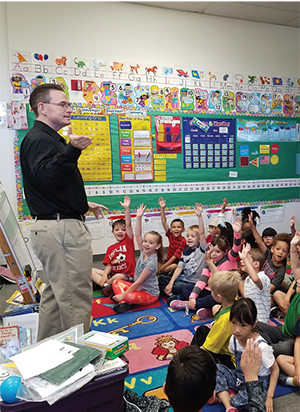 NSPE MEMBER CRAIG SISCO, P.E., F.NSPE, TALKS TO A GROUP OF KINDERGARTNERS IN NEVADA.
NSPE MEMBER CRAIG SISCO, P.E., F.NSPE, TALKS TO A GROUP OF KINDERGARTNERS IN NEVADA.James wanted to bring these kinds of activities to young people in Nevada so they could see the fun side of engineering.
In 2012, James and other Nevada Society members, volunteering their personal time, secured $2,000 in start-up funding and in-kind donations to make it happen. The members developed activities and rating sheets and assembled “bucket kits” full of supplies for activities such as building Ping-Pong ball catapults and rubber band cars. In 2013, the group conducted its first trial deployments, which included taking part in a science and technology festival through the Clark County School District.
By 2016, that group of volunteers, which has since become the Nevada PE Foundation STEM Outreach Committee, had reached more than 6,750 K–6 students and received several individual and corporate sponsors, according to committee chair Brook Demitropoulos, P.E.
James says that while they have not had the access to public schools like they thought due to time constraints and teachers’ obligations to prepare students for standardized tests, organizations like Boy Scout troops, Girl Scout troops, and Boys and Girls Clubs have been accessible avenues to introduce the concepts of engineering to grade school youth.
“The main thing is that we want to make it fun and hands-on,” James says. “It’s fun to put things together and make them work instead of being told to sit in your seat, come up with the right answer or else you get a bad grade. We want these kids to see us engineers as friendly, nurturing, and supportive people as opposed to socially awkward weirdos who do math all day, which I think is the impression a lot of young people get from the media.”
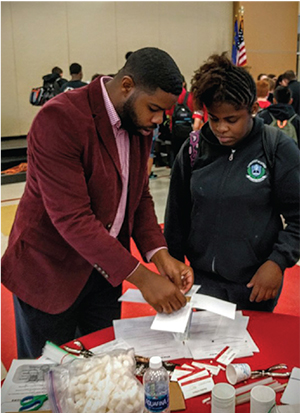 UNLV STUDENT TIMMIE JOHNSON GIVES A STUDENT INSTRUCTION DURING A RECENT STEM OUTREACH EVENT.
UNLV STUDENT TIMMIE JOHNSON GIVES A STUDENT INSTRUCTION DURING A RECENT STEM OUTREACH EVENT.James also says another problem with modern engineering, or at least its perception in popular culture, is that engineers are mostly white males.
“We’ve got to get engineering students that are not white males in front of these young people as well,” James says. “In southern Nevada, we are a majority-minority urban area. When I go out with engineering students most of the time, they are Hispanic, Asian, or African American. Kids need to be able to see themselves in these adult engineers, so it isn’t more off-putting.”
Demitropoulos says that by 2018, the committee had reached more than 13,000 students in southern Nevada. They also found volunteers in the ranks of engineers under 40, female professionals—especially mothers with young children—UNLV engineering students, and high school students.
“When we started convening the outreach committee and getting volunteers, a great majority of them were females that we had not seen before—many of them with kids,” James says. “What I realized was that these engineers want to share who they are, not only with their own kids, but with other kids. They saw this is an opportunity that they could believe in and get behind.”
The committee’s current goals are to continually develop, evaluate, and deploy new activities; find a trained cadre of volunteer professionals; and build its network of customers.
Maine
 RUSSELL MARTIN,
RUSSELL MARTIN,P.E., F.NSPE
For NSPE member Russell Martin, P.E., F.NSPE, being a benefactor for engineering and mentoring young people runs in the family.
His father, Robert Martin, P.E., was one of the charter members of the Maine Society of Professional Engineers in 1958, which became affiliated with NSPE in 1959.
“As I was growing up, I was exposed quite a bit to NSPE,” Martin says. “I remember as a kid we went to a few of the early annual meetings because of my dad’s role as a national director. He was very involved and was one of the leading forces behind our scholarship program that we still have to this day.”
Each year the Maine society gives two or three scholarships to Maine high school seniors who will attend accredited college engineering programs. The scholarships vary in amount, but Martin says they are usually around $2,500 each. The students must complete the first semester before receiving the scholarship money.
Throughout the years, MSPE has received anywhere between 30 and 50 applicants, Martin says. The scholarship evaluation, which his father oversaw and that Martin himself been a part of, narrows the candidates down to the top five or six. Those candidates are either personally interviewed or interviewed over the phone. The state society board then selects the scholarship recipients.
Serving in various roles for the Maine Society, including as president, treasurer, and secretary, and in various roles at the national level, Martin says, has put him in contact with many young, aspiring engineers.
He stresses the importance of Maine engineers promoting the profession to young students because of the state’s changing demographics.
“Maine is the oldest state in the nation in terms of average age,” Martin says. “A lot of engineers in the state are getting to the point of their career where they aren’t going to be working anymore. As the economy continues to grow, there’s going to be a huge need for engineers. I’ve always felt that it’s very important to steer as many interested kids as possible to get an engineering education. Even if they decide to go into another profession it gives them a good, solid base. It seems important to make sure that there are enough engineers in the future.”
The Maine Engineering Promotion Council is trying to do just that. The MEPC holds an annual expo attended by as many as 1,500 kids and parents eager to learn more about engineering. Martin says the expo and programs such as the FIRST Robotics Competition “are great ways to let kids see the more interesting and fun sides of what engineers do. PEs should be on the lookout for ways their society can get involved with events that go into places where there are young, enthusiastic minds ready to learn about what it means to be an engineer.”
Guam
 THOMAS CAMACHOS, P.E.
THOMAS CAMACHOS, P.E.
ELIZABETH GAYLE, P.E.
Stateside PEs aren’t the only engineers taking the next generation under their wing. Members of the Guam Society of Professional Engineers, Thomas Camacho, P.E., and Elizabeth Gayle, P.E., are doing their part to mentor young people.
Gayle, GSPE’s treasurer, has run the Guam MATHCOUNTS program for more than 20 years since its inception, which Camacho says has produced numerous licensed professional engineers, both in Guam and in the US mainland. As a former member and chairperson of the University of Guam’s Board of Regents, Gayle has been proactive in promoting engineering to middle and high school students at various public and private schools.
Camacho, a former GSPE president and a principal for the engineering consulting firm Duenas, Camacho & Associates Inc., is a member of the university of Guam School of Engineering Advisory Committee. In February 2019, the University of Guam established the School of Engineering where civil and environmental engineering courses will be offered.
Camacho is involved in the university’s Upward Bound Program, available to high school students. Upward Bound is a federally funded college prep program designed to motivate and assist economically and educationally disadvantaged high school students. During career exploration week Camacho volunteered as a representative of GSPE to do a short career presentation with a hands-on activity to offer additional insight into his work.
Camacho makes similar presentations at local high schools, including for his alma mater, Father Duenas Memorial High School. Camacho was involved with the university’s Fañomnåkan Spring 2019 Job Fair, where firms and associations met with students and alumni to offer job or internship opportunities, as well as prepare students with workshops in resume writing, application processing, job interviewing, and how to dress for success.
“We have a great cast of support PEs who do a great job in promoting the profession across the island,” Camacho says. “It’s important for kids in our community to see that they too can gain these skills and be a part of this profession.”
Read one member’s thoughts on the ethics of giving back to the profession.
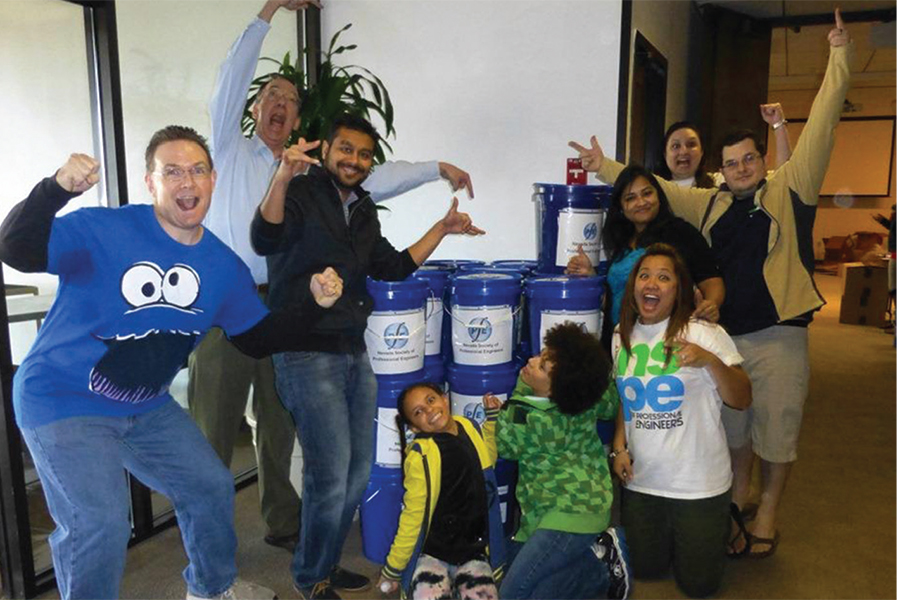
CRAIG SISCO, P.E., F.NSPE; DAVE JAMES, P.E., F.NSPE (FAR LEFT); AND OTHER MEMBERS OF THE NEVADA STEM OUTREACH FOUNDATION CELEBRATE PUTTING TOGETHER BUCKET KITS FOR AN UPCOMING EVENT.


 Volunteering at NSPE is a great opportunity to grow your professional network and connect with other leaders in the field.
Volunteering at NSPE is a great opportunity to grow your professional network and connect with other leaders in the field. The National Society of Professional Engineers (NSPE) encourages you to explore the resources to cast your vote on election day:
The National Society of Professional Engineers (NSPE) encourages you to explore the resources to cast your vote on election day: